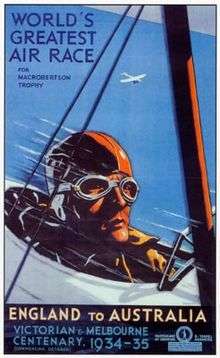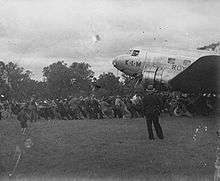MacRobertson Air Race

The MacRobertson Trophy Air Race (also known as the London to Melbourne Air Race) took place October, 1934 as part of the Melbourne Centenary celebrations. The idea of the race was devised by the Lord Mayor of Melbourne, and a prize fund of $75,000 (Australia used £ at that time) was put up by Sir Macpherson Robertson, a wealthy Australian confectionery manufacturer, on the conditions that the race be named after his MacRobertson confectionery company, and that it be organised to be as safe as possible.
The race was organised by the Royal Aero Club, and would run from RAF Mildenhall in East Anglia to Flemington Racecourse, Melbourne, approximately 11,300 miles (18,200 km). There were five compulsory stops at Baghdad, Allahabad, Singapore, Darwin and Charleville, Queensland; otherwise the competitors could choose their own routes. A further 22 optional stops were provided with stocks of fuel and oil by Shell and Stanavo. The Royal Aero Club put some effort into persuading the countries along the route to improve the facilities at the stopping points.

The basic rules were: no limit to the size of aircraft or power, no limit to crew size, no pilot to join aircraft after it left England. Aircraft must carry three days' rations per crew member, floats, smoke signals and efficient instruments. There were prizes for the outright fastest aircraft, and for the best performance on a handicap formula by any aircraft finishing within 16 days.
Take off date was set at dawn (6:30), 20 October 1934. By then, the initial field of over 60 had been whittled down to 20, including three purpose-built de Havilland DH.88 Comet racers, two of the new generation of American all-metal passenger transports, and a mixture of earlier racers, light transports and old bombers.
First off the line, watched by a crowd of 60,000, were Jim and Amy Mollison in the Comet Black Magic, and they were early leaders in the race until forced to retire at Allahabad with engine trouble. This left the scarlet Comet Grosvenor House, flown by Flight Lt. C. W. A. Scott and Captain Tom Campbell Black, well ahead of the field. This racer went on to win in a time of less than 3 days, despite flying the last stage with one engine throttled back because of an oil-pressure indicator giving a faulty low reading. It would have won the handicap prize as well, were it not for a race rule that no aircraft could win more than one prize.


Perhaps more significantly in the development of popular long-distance air travel, the second and third places were taken by airline transports flying regular routes with passengers, with the KLM Douglas DC-2 PH-AJU Uiver (Stork) gaining a narrow advantage over Roscoe Turner's Boeing 247-D, both completing the course less than a day behind the winner. Both were equipped with full variable-pitch propellers and had just completed test and development phases, and the DC-2 was flown without significant modification.




The most dramatic part of the race was when the Uiver, hopelessly lost after becoming caught in a thunderstorm, ended up over Albury, New South Wales.[1][2] The townsfolk responded magnificently - Lyle Ferris, the chief electrical engineer of the post office, went to the power station and signalled "Albury" to the plane by turning the town lights on and off, and Arthur Newnham, the announcer on radio station 2CO Corowa, appealed for cars to line up on the racecourse to light up a runway for the plane.[2] The plane landed, and next morning was pulled out of the mud by locals to fly on and win the handicap section of the race. In gratitude KLM made a large donation to Albury Hospital and Alf Waugh, the Mayor of Albury, was awarded a title in Dutch nobility.[2] Later that year (1934), the DC-2 crashed near Rutbah Wells (now known as Ar Rutba, Iraq), killing all on board, and is now commemorated by a flying replica.
| Official Finishing Order | |||||
|---|---|---|---|---|---|
| Aircraft type | Identity | Race No. |
Crew | Country of origin | Notes |
| DH.88 Comet 'Grosvenor House' |
G-ACSS | 34 | C. W. A. Scott, Tom Campbell Black |
Britain | Elapsed time 71 h 0 min Outright Winner |
| Douglas DC-2 'Uiver' |
PH-AJU | 44 | K.D. Parmentier, J.J. Moll, B. Prins, C. Van Brugge (died on board the attacked BOAC flight 777 in 1943) |
Netherlands | Elapsed time 90 h 13 min Winner on handicap |
| Boeing 247D 'Warner Bros. Comet' |
NR257Y | 5 | Roscoe Turner, Clyde Edward Pangborn, Reeder Nichols |
United States | Elapsed time 92 h 55 min |
| DH.88 Comet | G-ACSR | 39 | O. Cathcart Jones, K.F. Waller |
Britain | Elapsed time 108 h 13 min |
| Miles M.2F Hawk Major | ZK-ADJ | 2 | S/Ldr. M. McGregor, H.C. Walker |
New Zealand | Elapsed time 7 d 14 h Fastest single-engined |
| Airspeed AS.5 Courier | G-ACJL | 14 | S/Ldr. D. Stodart, Sgt. Pilot K. Stodart |
Britain | Elapsed time 9 d 18 h |
| DH.80 Puss Moth 'My Hildergarde' |
VH-UQO | 16 | C.J. 'Jimmy' Melrose | Australia | Elapsed time 10 d 16 h Second on handicap |
| Desoutter Mk.II | OY-DOD | 7 | Lt. M. Hansen, D. Jensen |
Denmark | Arrived 31 October |
| DH.89 Dragon Rapide 'Tainui' |
ZK-ACO | 60 | J.D. Hewitt, C.E. Kay, F. Stewart |
New Zealand | Arrived 3 November |
| Not classified | |||||
| Miles M.3 Falcon | G-ACTM | 31 | H.L. Brook, Miss E. Lay (passenger) |
Britain | Arrived 20 November |
| Fairey IIIF | G-AABY | 15 | F/O C.G. Davies, Lt.Cdr. C.N. Hill |
Britain | Arrived 24 November |
| Fairey Fox I | G-ACXO | 35 | Ray Parer, G. Hemsworth |
Australia | Withdrew from race at Paris. Eventually reached Melbourne 13 February 1935 |
| Lambert Monocoupe 145 Baby Ruth |
NC501W | 33 | J.H. Wright, J. Polando Warner |
United States | Withdrew at Calcutta |
| DH.88 Comet 'Black Magic' |
G-ACSP | 63 | Jim Mollison, Amy Johnson |
Britain | From Karachi, Mollison lost his way, and landed at Jubulpur. No high-octane fuel available, filled up with petrol. Engines "burned out" on flight to Allahabad. |
| Pander S4 'Panderjager' |
PH-OST | 6 | G.J. Geysendorffer, D.L. Asjes, P. Pronk |
Netherlands | Destroyed in ground collision at Allahabad.[3] |
| B.A. Eagle 'The Spirit of Wm. Shaw & Co Ltd' |
G-ACVU | 47 | F/Lt. G. Shaw | Britain | Withdrew at Bushire |
| Lockheed Vega 'Puck' |
G-ABGK | 36 | J. Woods, D.C. Bennett |
Australia | Overturned on landing at Aleppo, withdrew |
| Airspeed AS.8 Viceroy | G-ACMU | 58 | N. Stack, S.L. Turner |
Britain | Withdrew with brake trouble at Athens |
| Granville R-6H 'Q.E.D.' |
NX14307 | 46 | Miss J. Cochran, W. Smith Pratt |
United States | Withdrew with malfunctioning flaps, after landing damage at Bucharest |
| Fairey Fox I | G-ACXX | 62 | H.D. Gilman, J.K. Baines |
Britain | Crashed near Palazzo San Gervasio in Italy; both crew killed |
See also
Notes
- ↑ "The Uiver Memorial Aircraft". Albury City website. Albury City. Retrieved 16 June 2008.
- 1 2 3 "Flight of the Uiver". ABC Goulburn Murray website. Australian Broadcasting Corporation. Retrieved 16 June 2008.
- ↑ "De Panderjager uitgebrand in Allahabad". www.aviacrash.nl (in Dutch). Retrieved 3 February 2008.
References
- Lewis, Peter. 1970. British Racing and Record-Breaking Aircraft. Putnam ISBN 0-370-00067-6
External links
| Wikimedia Commons has media related to MacRobertson Air Race. |
- MacRobertson Air Race - State Library of NSW
- The MacRobertson Air Race, 1934
- Comet DH88 - fastest from England to Australia
- The Great Air Race, a TV Movie about MacRobertson Air Race
- The Uiver Collection, Albury NSW
- Tom Campbell Black co-winner of the MacRobertson London to Melbourne Air Race 1934
- 2CO Corowa site with many details and reminiscences from witnesses of De Uiver's landing at Albury
- 75th. ANNIVERSARY of the MacROBERTSON AIR RACE 1934-2009